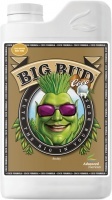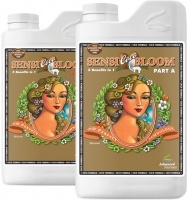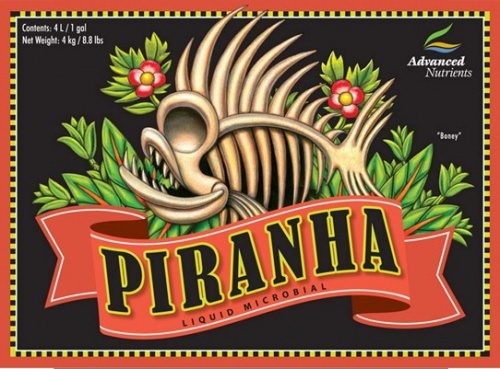-
Piranha
Advanced Nutrients
Evaluation 4.3/5 basé sur 9 voix
Voir la description complèteContiene 8 especies de tricodermas y 16 especies de endomicorrizas y ectomicorrizas, ácido húmico y leonardita. Maximiza la absorción de las raíces de oxígeno, nutrientes y agua. Maximiza el crecimiento de las raíces y ayuda a ganar más masa radicular.
-
-

- Advanced Nutrients Voir d´autres produits
-
Description du produit
-

Los hongos beneficiosos que el Dr. Hornby ha incorporado a Piranha son el perfecto complemento para Voodoo Juice. Mientras que Voodoo Juice coloniza la zona de las raíces con bacterias beneficiosas, Piranha hace lo propio con 24 hongos beneficiosos. Estos hongos consisten en 8 especies de tricodermas y 16 especies de endomicorrizas y ectomicorrizas. La tricodermas es un colonizador muy agresivo que incrementa la masa de raíces y controla de manera excelente la pudrición radicular, el pythium y la pytophetoria. Los hongos micorriza excretan poderosas sustancias químicas que disuelven los nutrientes minerales, absorben agua, frenan los elementos patógenos del suelo y unen las partículas de tierra en una estructura porosa. La micorriza puede expandir la superficie de la masa de raíces un 700%. Ambos, planta y hongos, se benefician de la relación simbiótica que los une.
Las investigaciones han documentado mejoras en la asimilación de agua y nutrientes por parte de la planta, y en la resistencia a una gama amplia de enfermedades del suelo y circunstancias medioambientales extremas. Las plantas florecen más abundantemente y requieren menos cuidados. La red micorriza es la world wide web de la madre naturaleza. Utilizar Piranha con nuestros dos productos de otros microbios beneficiosos (Voodoo Juice y Tarántula) creará una zona fértil.
No utilizar con Hy-Ox, puede dañar o matar a los cultivos beneficiosos (Tarantula , Piranha, Voodoo Juice). Piranha ha sido especialmente diseñado para utilizarse con todos los cultivos hidropónicos, coco, suelo, hidroponía, riego por goteo aeropónico, inundaciones y drenaje NFT.
Piranha, Cloning, Rooting, Germination & Transplanting
Application Rate: 0.3 g / L
Based on standalone light feeding
Using beneficial microbes to create a more natural environment for roots and leaves is the Advanced way of increasing plant health, growth rate, and yield. Piranha Beneficial Fungi colonizes root zones with eight species of trichoderma and 18 species of endomycorrhizal and ectomycorrhizal fungi. Trichoderma are energetic colonizers that enhance root mass while preventing root rot and other problems caused by harmful microbes, such as pythium and pytophethoria. Piranha works wonders for roots but is also a fantastic foliar spray that protects plants against harmful fungi that attack leaves and flowers, such as Pythium, Rhizoctania solani, Fusarium, Botrytis cinerea (grey mold), Sclerotium rolfsii, and Sclerotinia homoeocarpa. Mycorrhizal fungi excrete powerful natural chemicals that increase nutrient availability and root water retention, retard soil pathogens, and create a more aerated, porous soil structure. Mycorrhizal fungi can expand surface area of root mass by as much as 700%! Our research documented that Piranha improved root nutrient and water uptake while increasing plant resistance to soil diseases and environmental stress. Plants treated with Piranha have more flowers and fruit, and produce bigger harvests, especially when Piranha is used with its companion product, Voodoo Juice.
Piranha Use Details:
- In hydroponic systems, mycorrhizal colonization will turn roots light brown while increasing water absorption, nutrient absorption, and water retention efficiency.
- In hydroponics reservoirs, place Piranha in a nylon sock in the reservoir. This will reduce clogging of drip emitters.
Ingredients: Ectomycorrhizal Fungi, Endomycorrhizal Fungi, Humic Acid, Leonardite, Trichoderma-
Suggested Accompanying Products: CarboLoad Liquid, Tarantula, Voodoo Juice
Piranha - Points of Difference
1. Contains 6 super strains of beneficial fungi.
2 There are 4 super strains of Glumus and 2 species of Trichoderma, including a variant of strain T-22.
3. These mico-organisms dissolve nutrients, assists with H2O absorbtion, promote soil porosity (absorbtion), develop root mass, help plants resist stress, ensure better yeilds, enable faster establishment of fruits and flowers.
4. Piranha has the right number of fungal spores per gam to give the biggest and quickest response.
Piranha - Frequently Asked Questions
Q. Can I use Hy-Ox with beneficial cultures? ( Tarantula, Piranha, Voodoo Juice, Sensizym)
Absolutely not... Hy-Ox will damage or kill the beneficial cultures (Tarantula, Piranha, Voodoo Juice ) and may seriously affect the effectiveness of Sensizym
Q. Can I use Piranha on my outdoor crop and if so, what is the application rate?
Yes, Piranha can be used in outdoor crops. Follow the bottle instructions for application rates.
Piranha - Growing Tips
In hydroponic systems, mycorrhizal colonization will turn roots light brown while increasing water absorption, nutrient absorption, and water retention efficiency.
In hydroponic reservoirs, place Piranha in a nylon sock in the reservoir. This will reduce clogging of drip emitters.
Do not use biologicals in conjunction with Hy-Ox as it will kill the beneficial organisms rendering them ineffective.
Do not steep Piranha in hot water - water should be room temperature or slightly colder
Piranha - Technical Description
A) Piranha is a Mix of Mycorrhizal Super-Strains:
Farmers and horticulturists around the world rely on the symbiosis between beneficial fungi and their plants in order to maximize yield and crop health. Whether they inoculate or practice intensive organic techniques, their goal is to develop huge colonies of beneficial fungi to sheathe and grow into all root tissues in their crops.
Piranha is a mixture of purified mycorrhizal spores developed by agronomic scientists who have grown them into pure strains. Piranha is a powdered concentrate of these spores collected from six super-strains of mycorrhizal fungi that will grow in all gardens.
In this powdered format the spore concentrate will last up to two years; the spores of these beneficial fungi are extremely durable and will germinate as soon as conditions permit.
Piranha is a purely mycorrhizal product; it contains fungal spores. Advanced Nutrients also makes Tarantula and Voodoo Juice which are beneficial bacterial strains that can also be used with Piranha.
B) The benefits of using Piranha:
Beneficial fungi called mycorrhizae grow into root tissue and even around roots, which both protects the root tissue and expands the absorptive surface area of the roots many thousand fold. Garden growth becomes unrestrained when the absorbed nutrient inputs are made available in unlimited capacity to your plants.
Beneficial fungi that grow on a host plant form vast networks of mycelium, the filamentous structures that creep through soil, which will transport water and nutrients back to the root tissue. This capacity for water and nutrient absorption is vastly greater than the plant could accomplish on its own.
The different genera of mycorrhizae in Piranha vary in their symbiotic functions but Piranha combines the advantages of Trichoderma and Glomus species. Trichoderma grows symbiotically on the outside of roots branching its mycelium from the root epidermis deep into the soil while Glomus grow inside the root. The super-strains of Glomus in Piranha are endomycorrhizae living deep into root tissues, and form a sheath with their mycelial growth around roots before exploring the soil-scape. These are the “inner-wear” that roots cover themselves with, while Trichoderma is like the “outer-wear” of mycorrhizal growth root always seek to clothe themselves with.
Mycorrhizal fungi will solubilize many nutrients by secreting organic acids, so even before they transport nutrients back to roots, they work to chemically change the soil so nutrients become dissolved in the soil solution. These nutrients are then available for root tissue to uptake directly, anywhere in the rhizosphere.
Beneficial fungi will turn on the plants immune system; the symbiotic relationship allows for an “infection” of root tissue by the mycorrhizae which stimulates the plant’s own systemic immunity response. This prepares the whole plant for any future attacks by pathogenic fungi or insects. Trichoderma and Glomus synergistically stimulate the plant immune system to make all defensive proteins, not just certain classes of these defensive enzymes.
Mycorrhizal networks are able to connect separate plants underground, even plants of different species; scientists have shown that these mycelia networks will exchange carbon and minerals between plants, bringing the scope of the symbiosis to a high level of integration. In highly productive soils, mycorrhizae will connect a whole ecosystem of plants, exchanging nutrients and metabolic signals throughout the garden.
Piranha is concentrated to deliver 1.4 billion viable spores per gram; this concentration ensures that the benefits of the symbiosis take hold immediately. Piranha’s spore types are selected to be able to interact with the bacterial strains in Tarantula and Voodoo Juice; these beneficial bacteria make Glomus spores in piranha germinate more rapidly, and act symbiotically microbe to microbe.
C) The Ingredients of Piranha:
There are six super strains of mycorrhizal fungi in Piranha. Two are strains of Trichoderma, and four are Glomus species.
Certain Trichoderma species greatly stimulate the plant’s immune system while symbiotically inhabiting the outer layers of root tissues. The Trichoderma in Piranha cannot penetrate much into root tissues, and so this strain fills the micro-niche just outside and surrounding roots.
Instead the Glomus species of mycorrhizae in Piranha live more deep inside the roots of plants, and they grow a sheath-like coating on roots they proliferate within. These are also called vesicular-arbuscular mycorrhizae, or VAM, meaning “tree-shaped-vesicle” mycorrhizae.
VAM grow specialized, miniature organs into the tissue of roots called “haustoria”; these are the intracellular exchange sites for nutrients where the symbiosis is happening at a molecular level. The mycelium then extrudes outside of the root and grows around it, externally, but close to the root.
D) 1. Mycorrhizae Cover All Roots; There Are No “Naked” Roots in Soil:
Where ever they grow, it is virtually impossible to find plants that have 'bare' exposed root tissue; all roots are coated or sheathed in layers of symbiotic fungi. These beneficial associations involve many kinds of fungi that also live in the soil, hiding away from light, living only with plant tissue. Even when growing hydroponically or without soil-based media, plant roots will make every effort to 'clothe' themselves with beneficial fungi.
These 'clothes' are the mycelium of these symbiotic fungi, and they take on characteristics of 'outer wear' and 'inner wear'. Some symbiotic fungi grow into the cells of root tissue and are called 'endomycorrhizae', like the Glomus super-strains in Piranha. Other beneficial soil fungi such as the Trichoderma super-strains in Piranha grow only as an outer layer on roots; these are called ectomycorrhizae.
In a soil based garden, the outer surface of a root is usually pure mycelium of ectomycorrhizae, sometimes a translucent beige, brown or black coloured 'skin' one can peel off of mature, older roots.
The way that plant roots select which types of fungi to clothe themselves in is very species specific. The fungi too actively seek out roots to colonize, and are baited by the roots that exude nitrogenous carbohydrates; these are a slimy material that is also a precious food substance for mycorrhizae.
Sub-strains and sub-mutations of fungal types differentiate the intricacies of the symbioses that occur underground into an impossibly complex weave of cellular activity. All sorts of beneficial fungal species strains will compete to grow on new, exposed roots. Mycelium of one fungus will colonize multiple plants, feeding nutrients back and forth.
This web of growth upon growth, both outside of roots and inside root cells is usually so close that it would be like the clothes you wear becoming annealed to your body, and growing through themselves. They would become your life-support clothing, not only nourishing you but also acting as your “armour” defending you against pathogens, and giving you protection from stressful environmental changes.
Advanced Nutrients' Piranha is the equivalent of a “shopping mall” full of mycorrhizal “clothing and active-wear” for new roots. We provide a complex mixture of mycorrhizal spores in one container; a plant can pick and choose its 'entire wardrobe' from our formulation of fungal inoculants for the rhizosphere, but all are super-strains of aggressive mycorrhizal fungi.
2. Examples of How All Genetic Traits are Enhanced Including Yield, with Mycorrhizae in Piranha:
Scientists speak of plants as having “mycorrhizal dependence” in order to fully express their genetic potential, and some species of plant cannot survive at all without copious root symbionts. Using Piranha the grower caters fully to the mycorrhizal dependence of any garden, saturating the rhizosphere with the spores of symbiotic Glomus and Trichoderma fungi.
In an experiment with essential oil bearing plants called “Mycorrhizal Association of Glomus spp. with Palmarosa Enhances Growth and Biomass”, reported in 1991 from the journal Plant and Soil, vol. 131 we can find an example involving the essential oil producing citronella plant. In this study the effects of inoculating greenhouse grown citronella plants with Glomus aggregatum were shown to increase plant biomass on the order of 3 times more than that of the un-inoculated controls!
These kinds of experiments with extreme improvements in yield are being conducted on all crop types. They show how in spite of the level of environmental and nutrient inputs being given to plants, the full vigour that the plant was able to grow with was not being expressed unless Glomus mycorrhizae were abundantly living on and around the plants.
The Glomus mycorrhizae that were studied growing on and inside citronella roots enabled the full genetic expression of the plants, tripling growth, increasing nutrient uptake, nutrient utilization and enhancing oil production. All higher plant’s ecological adaptability includes this “switch” that growers can turn on to a full-potential for growth by using Piranha.
Imagine what your aromatic herb garden might be missing without Piranha, and how simply this biological mechanism can be exploited with any growing system; soil or hydroponic, and especially by organic growers!
In an example with a staple agronomic such as crop, scientists have shown that inoculants of Glomus species of mycorrhizae will readily colonize root systems and bring about assorted improvements in metabolism and yield. In the journal Plant Nutrition, vol. 22 (1992) reports about these trials showed that the dry mass of corn leaves was increased by 16 – 24 % due to inoculation with glomus mycorrhizae.
In corn crops glomus inoculation also increased the chlorophyll content of the leaves, meaning that overall more photosynthesis was possible in the inoculated plants. These same plants also had higher amounts of stored protein compared to un-inoculated controls.
The ability to make more of everything, from green pigments to the enzymes and structures required for growth is triggered by the symbiotic mycorrhizal “infection”; this is a very mutualistic cellular relationship all growers can exploit, and it is being studied all over the world.
In Hawaii endemic flowering tree species have been shown to increase in growth as a result of inoculation with Glomus mycorrhizae. In this example published in the American Journal of Botany, vol. 89 (2002), studies show that these plants are accustomed to growing on nutrient poor soils, and in harsh, dry climates, but the addition of glomus fungi to the root zone enabled shoot growth to increase from 2 to 7 times the size of untreated controls! Phenomenal unleashing of genetic potential !
Some of the most drought tolerant plant species require Glomus mycorrhizae to thrive. Your experience will show how frequent use of Piranha can immediately improve growth. Especially during crop start-up, Piranha has a valuable effect in turning on the symbiotic process so no growing-time is ever wasted.
The entire vegetative period and early blooming phases of growth will drastically benefit from inoculations with Piranha as well. Piranha can be washed into the root zone during every fertigation event. When used as directed Piranha delivers 1.4 billion spores of Glomus and Trichoderma super-strains that immediately flip the expression of genetic potential to “full”, very likely pushing growth to previously unseen highs.
3. A Study on The Glomus Mycorrhizae Associated with Roots of Aromatic Herb Plants:
Aromatic Herb growers have noted that proper growth requires that plants grow with an abundant amount of VAM within root tissues. Scientists in India studying Basil, an essential oil bearing plant, have characterized the symbiotic associations found on various Ocimum strains, and one account is given in the Journal of Herbs, Spices, and Medicinal Plants, vol.7 (2000).
In an article called “Vesicular arbuscular Mycorrhizae associated with Ocimum spp” scientists describe the Basil crop’s significance:
“Ocimum spp. (Labiatae, ie Basil) are important essential oil bearing plants of tropical and subtropical climates. Essential oils of Ocimum species, rich in camphor, citral, linalool, linalyl acetate, eugenol, thymol, geraniol and other constituents are commonly used in the perfumery and cosmetic industries (15).”
The fundamental importance of VAM symbiotic fungi are outlined by the scientists studying the basil plants essential oil production, and they remind us about the mycorrhizal-dependence of some species:
“…VAM fungi are ubiquitous in nature and form viable and stable symbiotic associations with plant roots. Symbiosis has been demonstrated to affect the physiological processes of some host plants to improve nutrient (10) and water uptake (11) and thus, enhance productivity. Sometimes host plants will not grow without the association of VAM fungi, especially in sandy, phosphate deficient soils (12).”
These scientists in India recognized that in order to express the full genetic potential of these essential-oil bearing crops, they had to utilize the mycorrhizal symbiosis with certain strains of VAM. By looking at the most vigorous plant’s roots, they found the same genera of mycorrhizal fungus as found in Piranha.
This work was an initial screening for isolating mycorrhizal super-strains they sought to improve commercial crop yields, both in terms of quantity and quality. They state:
“…The essential oil also plays an important role in the Indian system of medicine, being used for the treatment of colds, coughs, fevers, headaches, and general lack of vigor. Thus, changes in cultivation techniques that improve the qualitative and quantitative production of essential oil are important to meet demand. Vesicular-arbuscular mycorrhizal (VAM) fungi play an interesting role in improving the productivity of most of agricultural crop plants.”
The amounts of plant material and the rich aromas generated by the basil crops grown commercially in India can be enhanced directly by using the mycorrhizal strains in Piranha. Advanced Nutrients selected proprietary super-strains of the Genus Glomus to formulate into Piranha; these strains are of the same genus that was being studied in India on essential oil bearing Ocimum plants.
The scientists screened the basil plant roots for symbiotic fungal species, finding a series of Glomus strains were present where ever growth was most enhanced. It was a simple enough task to find them since the taller, larger and more productive essential oil bearing basil plants had roots that were covered in these VAM:
“…a total of seven VAM fungi, identified as Glomus fasciculatum, Glomus geosporum, Glomus aggregatum, Glomus mosseae, Gigaspora spp., Sclerocystis sinuosa and Acaulospora spp., were observed to be associated with the tested Ocimum species. The predominant VAM fungi (Glomus species) were associated with all the Ocimum species.”
The basil plant (Ocimum) was shown to increase its growth rate whenever associated with the same genus of mycorrhizae found in Piranha. Only Glomus was found on all strains of basil. But the scientists also looked for other species of beneficial fungi on the Basil (Ocimum) plants, noting some host-specific ones:
“…species of Gigaspora and Acaulospora were limited in number and observed only in the rhizosphere soil samples of Ocimum basilicum. Sclerocystis sinuosa was observed only with Ocimum gratissimum and Ocimum kilmandscharicum. Root colonization of each species differed widely. Maximum root colonization was noted with Ocimum basilicum (Indian basil) (62.8%) and Ocimum basilicum (French basil) (60.2%). The lowest level of colonization was observed with Ocimum gratissimum (35.2%).”
Advanced Nutrients’ Piranha contains a series mycorrhizae of the same genus called Glomus which are the VAM so often associated with essential oil bearing plants. We chose to combine only Glomus super-strains of the same genus as these scientists found to be most intensely symbiotic with Basil, increasing yield all around. Glomus species of mycorrhizae are always found with healthy plants, especially on sub-tropical aromatic herbs like basil. They state further that:
“The root colonization of Ocimum spp. by VAM-fungi may bear considerable economic significance because such colonization has been demonstrated to dramatically improve biomass yield of other medicinal and aromatic plants ... Thus, the addition of suitable VAM fungi to the rhizosphere could be expected to significantly improve the growth and productivity of commercial Ocimum spp. plantings. …The reasons for the different levels of VAM association with different Ocimum spp. are unknown, but undoubtedly relate to differences in the genetic make-up of the plants. VAM fungi are known to be attracted to plants by root exudates … and differences in such exudates among the species could well account for the differences in fungi association.”
The scientists examining basil’s VAM remind us that plants differ in their ability to “bait” mycorrhizal fungi, but in Piranha the fungi themselves are prowling for roots to colonize. They are genetically superior, “super-strains” that have an enhanced growth promoting, symbiotic effect, and a more aggressive ability to colonize root tissue of host-plant species.
The Glomus species in Piranha can vigorously infect and then inhabit a broad range of plants, meaning that Piranha can be used to enhance the growth of virtually all plant types, not just essential oil bearing plants like Basil. The series of strains we use assures that there is a broad effectiveness across many plant species.
For the gardener interested in promoting even higher biodiversity in their garden root zone Advanced Nutrients has designed Tarantula and Voodoo Juice as compatible and complementary products for Piranha. These bacterial supplements promote and support the germination of the spores in Piranha; the interested reader is referred to the Technical Descriptions for these products for further details.
4. The Trichoderma Species in Piranha:
Piranha also contains spores of Trichoderma mycorrhizal fungi; these complement the way that Glomus VAM find their niche in the rhizosphere. Trichoderma only infect into the outer cell walls of plant roots, but grow profusely into the space outside the root. The Trichoderma in Piranha will introduce metabolic activity around the roots that symbiotically protects and promotes growth of your plants.
When the scientists examined how Trichoderma grew into roots, they saw that trichoderma hyphae grew into the root tissues, fusing its cell wall with the cell wall of the root cells, stopping in the outer layer of the roots. This was a very controlled infection.
In the cucumber roots infected with Trichoderma, large cellulose and callose deposits (new cell wall) formed around the symbiotic fungi. The new cell wall was like a coating and blocked them as they grew into the cucumber roots. When plants are infected with trichoderma they can handle the infection, allowing it to happen, but walling it off.
The symbiotic strain of Trichoderma in Piranha is also recognized as a beneficial organism. This happens since the Trichoderma’s cell wall is not digested by the plant, and becomes protected in the plant’s new callose and cellulose deposits. The symbiotic Trichoderma seem to trick plant cells to do this; they make them selves a home from the busy and growing root cells, over-stimulating them for cell wall growth around where they infect.
Plant scientists have shown that the controlled infection by Trichoderma turns on plant systemic immunity while it walls-off the Trichoderma infection site. The controlled infection by Trichoderma enables the genes involved in the plant’s defence mechanisms to become “potentiated” which means the plant genes are able to respond quicker and with greater output of defence if a more threatening pathogen were to appear.
In the journal Plant And Soil (vol. 173) from 1995 similar studies using citrus plants have shown that trichoderma infection induces plant cells to make protective enzymes called trehalases, phosphatases, esterases and chitinase. These are also proteins that the whole plant makes to fight off the infections of other pathogens.
The plant’s response to make new enzymes such as these is a systemic resistance, where all cells are all over the plant activated to make these defence proteins from their genes. This is part of the microbial benefits of using Advanced Nutrients’ Piranha; your garden will acquire enhanced systemic resistances when our Trichoderma are growing with your plants.
Another example of how Piranha’s Trichoderma induce systemic resistance in plants is found in the journal called Applied Environmental Microbiology vol. 65 (1999). Here scientists published a report showing that when certain strains of trichoderma infect cucumbers, they will elicit the production of new protective enzymes called peroxidase and chitinase in the plant. This happens all over the plant, within 48 hours of infection, caused by a turning-on of the genes coding for these proteins, in direct response to Trichoderma infection.
5. How Trichoderma Keep Pathogenic Fungi and Bacteria Away from Plants:
Trichoderma are a well studied genus of beneficial fungus; some are symbiotic and beneficial to plants while others are disease causing. Scientists have isolated many strains and characterized the genetics of many types of this fungus. The beneficial Trichoderma are quite common in soils.
We can find an in depth review of their biology in an article called “Trichoderma Species — Opportunistic, Avirulent Plant Symbionts”, published in the journal Nature Reviews, vol. 2 (2004). The title is perfectly descriptive of how a controlled Trichoderma infection of the right symbiotic strain, benefits plants. The authors state:
“Trichoderma spp. are free-living fungi that are highly interactive in root, soil and foliar environments. It has been known for many years that they produce a wide range of antibiotic substances and that they parasitize other fungi. They can also compete with other microorganisms; for example, they compete for key exudates from seeds that stimulate the germination of propagules of plant-pathogenic fungi in soil and, more generally, compete with soil microorganisms for nutrients and/or space. Furthermore, they inhibit or degrade pectinases and other enzymes that are essential for plant-pathogenic fungi, such as Botrytis cinerea, to penetrate leaf surfaces.”
The modern gardener using Piranha will inoculate their rhizosphere with the most beneficial strains of Trichoderma known. These “mop-up” all nutrients and feed them to the plant roots before pathogens can use them. Advanced Nutrients selected the most symbiotically aggressive Trichoderma known to microbiologists for packaging into Piranha.
The scientists reviewing the biology of Trichoderma describe the knowledge base we have accumulated about these species further:
“These direct effects on other (pathogenic) fungi are complex and remarkable and, until recently, were considered to be the basis for how Trichoderma spp. exert beneficial effects on plant growth and development. Research on these topics has generated a large body of knowledge, including the isolation and cloning of a range of genes that encode proteins of which some have antimicrobial activity.... This research has also produced several useful findings, including that genes that encode fungitoxic cell-wall-degrading enzymes can be used to produce transgenic plants that are resistant to disease (9–11), and the discovery of enzymes that are useful in the bio-processing of chitin.”
Piranha will devour the competitive, non symbiotic fungi, eating up their food supplies, or physically digesting them for food, while being able to grow in the plant tissue protecting itself, and enhancing the plant tissue to grow. Pathogenic bacteria are also deprived of food and a niche to grow in when Trichoderma are abundant. A garden without a rich growth of the trichoderma found in Piranha is left open for colonization by pathogenic species; the trichoderma in Piranha physically digest their way into the cell walls of pathogenic fungi, and deprive them of their space to grow in.
This happens so effectively with Piranha since we have combined an aggressive series of Trichoderma strains with a select group of Glomus mycorrhizae; these make Piranha full of beneficial strains of mycorrhizae that are genetically superior and nothing can escape their ability to colonize the rhizosphere. The Trichoderma fill the space outside and around root tissues, while the Glomus coat roots and develop “feeder” organelles called haustoria that grow into root cells.
But as mentioned briefly above, the “superficial infection” by Trichoderma as it grows into plant tissue, has even more amazing consequences:
“In addition to the ability of Trichoderma spp. to attack or inhibit the growth of plant pathogens directly, recent discoveries indicate that they can also induce systemic and localized resistance to a variety of plant pathogens. Moreover, certain strains also have substantial influence on plant growth and development. Their enhancement of plant growth has been known for many years and can occur in both Axenic systems (13,14) and natural field soils(15,16). These new findings are dramatically changing our knowledge of the mechanisms of action and uses of these fungi. We now consider that the direct effects of these fungi on plant growth and development are crucially important for agricultural uses and for understanding the roles of Trichoderma in natural and managed ecosystems.”
At Advanced Nutrients we also considered how this knowledge and modern microbiological technology can breed pure, super stains of Trichoderma. Piranha is as an essential tool for the modern hydroponic and home gardener. Combined with the Glomus super-strains, the Trichoderma in Piranha leave all the spaces roots inhabit festooning with symbiotic fungal growth; mycorrhizal mycelium feeds and protects from the inside-out and outside-in.
E) How to Use Piranha:
Advanced Nutrients' Piranha contains a concentrated blend of endo' and ectomycorrhizal spores of the genera Glomus and Trichoderma. These beneficial fungi have been shown to assist the roots of plants in procuring nutrients and water, and in developing drought and pest resistances.
Piranha can be used from the start of a garden at germination or at transplanting. At the first 2 weeks of growth use Piranha at 1.0 g per litre of water.
Apply Piranha at 0.3 g per litre of irrigation water every time you water your garden. Endo' and ectomycorrhizal fungi are always in direct contact with roots in order to survive. Mycorrhizae depend on roots for survival.
For maximizing the growth effects of Piranha regular application at 0.6 g per litre during vegetative growth is ideal.
After starting crops with Piranha and growing with regular use of Piranha during vegetative phase, it can be discontinued at the third week into a blooming cycle.
Keep the nutrient solution containing Piranha continually agitated to ensure even distribution with every watering. Alternatively make a separate solution of Piranha to apply all at once.
Piranha can be applied as a foliar spray at 1.0 – 2.0 g per litre. Filter-less injectors are recommended, and constant agitation of the injection reservoir will ensure even distribution.
When applying Piranha foliarly it is also desirable to follow up with a rinse of water or another foliar spray to wash residual spores towards the soil; foliar treatments are most effective on young vegetative crops and tender, new shoots.
Advanced Nutrients’ Piranha has a shelf life of up to two years. This is because we have packaged just the dry spores of the beneficial mycorrhizal fungi; there are no perishable additives requiring refrigeration.
These spores remain dormant until they encounter water and the specialized carbohydrates that are exuded from roots. When roots are actively growing they always excrete these carbohydrates, so a dormant mycorrhizal spore will become active only when roots are actively growing nearby. The moment you add Piranha to your garden, the spores go to work, feeding and protecting the roots of your crops.
D´autres produits en Advanced Nutrients
-

-
Big Bud Coco
12,03€Avant: 13,00€
-

-
Bud Ignitor
24,00€Avant: 25,95€
-

-
Bud Factor X
23,13€Avant: 25,00€
-

-
Sensi Bloom Coco A - B
32,38€Avant: 35,00€
-

-
Revive
17,22€Avant: 18,62€
-
-
Avis des clients (0)
Evaluation 4.3/5 basé sur 9 voixVous devez vous identifier pour écrire des commentaires.
-
